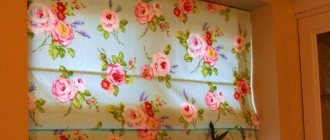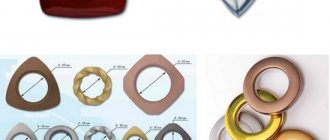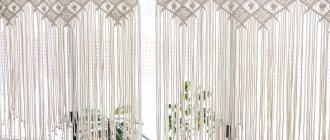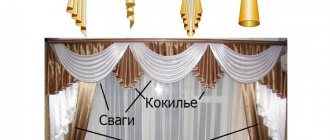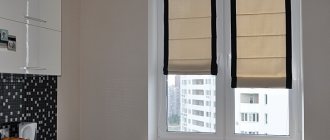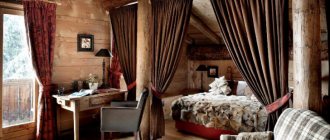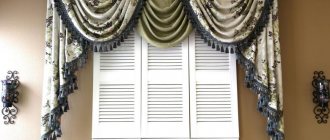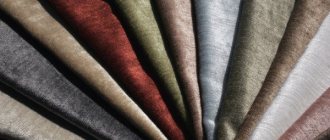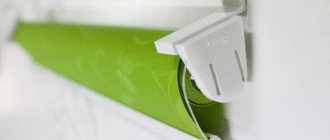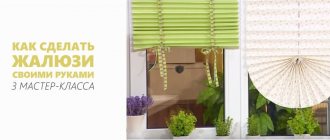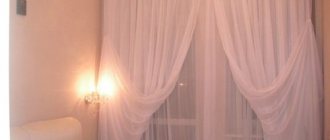Sewing curtains yourself is easy, because there are many master classes on this topic. How to sew curtains with the correct pattern, this issue has its own characteristics.
General sewing rules
How to sew curtains? So, this is a large piece of material that anyone can sew. Neat curtains can be sewn by following these rules.
- Prepare for sewing. Choose the material that you like best, consider the density.
- Calculate the fabric. Curtains are divided into: tulles and drapes. Calculate the size using the height of the window or wall and the length of the cornice. Consider the hems of the bottom and top, as well as the gathering factor.
- Take care of further care. Take any piece of fabric before you buy the entire fabric and try washing it with the product you will use in the future, in order to protect yourself from deformation of the seams. Another way to find out about care is to ask a sales consultant.
- Cut before sewing. Before working with the main fabric, it is better to do the first cutting and sewing option on any other, so you will take into account all your mistakes. Determine the front side. The curtains will be placed vertically on the window, so a precise, even seam will be visible. Don't forget about the pattern; if there is one, it should be symmetrical with the other curtain.
- Create a pattern according to your measurements. A pattern of length, width and height is created on graph paper or tracing paper.
- Open the fabric. Trace the pattern with chalk or a felt-tip pen and cut along the contour.
- Process the edges using a sewing machine , remembering accuracy and safety precautions.
Required tools and materials
Includes both auxiliary and basic materials. To sew tulle or curtains use:
- A sewing machine is equipment that can be used to sew products and make even and clean seams.
- Presser feet for a sewing machine , they come in different types; they are needed for curtains: for finishing edges and for main seams.
- Pins - safety pins or tailor's pins - are needed for basting and hemming the material.
- Sharp scissors , use tailor's scissors, but if you don't have them at hand, use sharp ones;
- The iron is the main equipment, as it is needed for the stage when working with the product. First of all, they are processed, ironed and steamed, and at the end of the work, they are also ironed well.
- Needles and threads for basting and sewing seams , it is better to baste by hand and then sew on a machine.
- Graph paper or tracing paper.
- Pen, felt-tip pen, pencil or chalk.
- A flap will help you choose fabric and needles for your sewing machine.
- Curtain tape , it is needed to attach the product to the cornice, otherwise called braid.
Loops
Wide short stripes are made from the same or additional contrasting fabric, which are sewn in the form of loops evenly along the upper edge of the curtain. The loops can be either stitched or fastened with large decorative buttons sewn to the curtain. Another option would be to tie a loop into a bow.
Choosing fabric for sewing
How to sew curtains for the kitchen, living room, bedroom and other rooms? So, it’s worth deciding what kind of curtains you want to make for your interior. If it is tulle, then the fabric can be different:
- Organza. The material it is made of is polyester or viscose. The advantages are that it allows sunlight to pass through, dries quickly and does not wrinkle. The downside is low breathability.
- Veil. Material: natural fibers. Pros - breathable material, that is, high air permeability, does not electrify, does not attract dust. The downside is that it requires delicate care, since natural fibers have the ability to deform when washed.
- Net. The classic look of tulle, made of synthetic threads. It allows air to pass through well and matches with curtains of different colors and patterns. The downside is that it is highly electrified, which requires quite a bit of maintenance.
- Muslin. Cotton material, natural. Pros: pleasant to the touch, has many shades. Cons: It wrinkles quickly and requires constant ironing.
- Chiffon. Material: cotton or silk. Pros: attractive appearance, good air permeability. The downside is that chiffon is difficult to work with for beginners and is expensive.
For curtains you need others, here the density is greater, they are not light like cotton fabrics, since they protect from the sun.
Therefore, the following options are recommended:
- Linen. It will last a long time, is resistant to ultraviolet radiation, dirt and stains are easily washed off, and is quite durable. Disadvantages of linen - price, deformation after washing, because... requires special care.
- Matting. The material is coarse and made in a checkerboard weave. The advantages of matting are that it does not require maintenance, has an impressive appearance and is wear-resistant. Disadvantages - in the filing, in the sprinkling of the edges, there are puffs left.
- Gabardine. Material: wool, cotton, silk. Gabardine is dense due to the weaving of the threads diagonally. Pros: breathable, waterproof and easy to care for. Cons - crumbles.
- Velvet. Chic, luxurious fabric is used in a classic interior. Pros - does not allow sunlight to pass through, does not fade, provides good sound insulation. Disadvantages - they are harmonious in large rooms, the cornice on which the curtains are hung must be well attached to the wall.
- Jacquard fabrics. Made with drawings or ornaments. Stylish, but unfortunately not suitable for all interiors. They are easy to care for and do not fade in the sun.
Stylish component
When the technology for sewing curtains is determined and the fabric is selected, the question of aesthetics arises. Everyone wants home to be a place where it is always cozy and comfortable. It is textiles, in particular curtains, that add coziness to any room. So which ones should you choose?
If the interior is saturated with bright colors, you should pay attention to colored curtains that will complement the existing design. You can take a color that is already present in the interior, but choose a softer and more pastel shade. Remember that any shades differ in warmth, and a cooler shade of a color already present in the interior will look inharmonious. When choosing colored tulle and bright curtains, you need to focus on filling the room with light. In a bright room, colored tulle looks vibrant and bright, but if there is little sun, it will seem heavy and dark.
You may also be interested in: Design of pink tulle in the interior - tips with photos
The most classic option in the style of minimalism is white organza fabric. You can choose curtains of any color to match it. But don’t think that choosing white organza is easy. It can also be cool white, ivory or pearlescent. Each shade will look different and suit completely different interiors. You should not try to combine several shades of white; this task is extremely difficult, and not even every professional designer will be able to choose the combination correctly.
Whatever fabric you choose, whatever color and style you choose, now you can sew tulle with your own hands.
Save
Calculation of fabric cuts for curtains and tulle
So, first of all, you need to know how much material you will need, for example, for a do-it-yourself Roman blind. The length of the cornice is measured, and the gathering factor is taken into account, usually it is 2. Using these values, the fabric consumption for the tulle is calculated. Multiply the length of the cornice by the assembly factor.
The consumption for curtains is calculated with folding elements according to the dimensions of the curtain height, bottom hem and top hem.
Uncover
To cut correctly, you will need a grain thread: it makes cutting easier, since there will be no deformation of the product, and you will not get asymmetrical curtains for the kitchen, living room or bedroom.
- draw a pattern by elements;
- small details are indicated;
- trace the constructed pattern from the wrong side, not forgetting about seam allowances;
- To prevent the material from shifting while tracing the pattern, it is better to pin the paper to the fabric;
- cut with sharp scissors.
Correct cutting of the canvas
Before sewing tulle, great attention must be paid to cutting the fabric, which cannot be done in the usual way, since the edge will be uneven and may begin to “creep”. To do this, use one of 4 methods, namely:
- along the ironed fold, the exact location of which is determined by measuring equal distances along the entire length of the canvas using a measuring tape or tape measure. Then, following these marks, the fabric is folded and ironed. Cutting is done from the inside using a sharp knife;
- along the trace of the thread, which is pulled out of the fabric, having previously made a small incision in the required place. When these actions are performed correctly, a noticeable mark remains on the material, along which the fabric is cut with scissors;
- arshin and scissors. To do this, the fabric is spread out on a flat surface and with the help of an arshin (a flat long wooden strip), many points are marked on the fabric using a marker. By removing the arshin, a line of dots will remain on the fabric along the entire length of the fabric. It is necessary to cut along it;
- arshin and cutter. In this case, a protective element in the form of a piece of plywood is placed under the fabric, laid out on a flat surface, the arshin is placed on the tulle, pressed and the cutting is performed with a cutter.
When using an iron, to achieve an even cut on tulle, it is necessary to use a thin soft cloth between the soleplate of the device and the material. Otherwise, the material can easily be damaged - burned or left with yellow spots.
How to fold fabric correctly
There are step-by-step instructions for performing a hem:
- Once you iron the material you are going to sew, measure from the top edge the same amount of cm as the width of the curtain tape. Bend the measured cm inward and go over it with an iron, thereby fixing the bend with steam.
- After either using pins or basting with a thread and needle, secure the hem.
- Use your sewing machine and make sure the sewing machine foot is positioned along the edge of the folded fabric.
Tulle
Most window design models include the use of tulle. That is why this option is being considered first.
Required material
In this case you will need:
- A piece of thin translucent fabric;
- Special tape;
- Colored threads.
Instructions
- In this case, the width of the fabric should correspond to twice the width of the window. The length consists of the sum of the desired length of the curtain, ten centimeters for the hem at the bottom and three centimeters for the hem and processing with tape at the top.
- The process is so simple that there is no need for a pattern. Using a ruler or measuring tape, points are marked on the laid out material according to preliminary measurements and connected to each other. The workpiece is cut along the resulting lines. For convenience and space saving, the fabric can be folded in half.
- The upper part of the curtain should be folded inward by half a centimeter, smoothing it with an iron. Next, you need to once again bend the edge of the fabric inward by two centimeters, securing it with safety pins or ironing it again. Thus, this will take five centimeters of fabric. Now you need to make a neat stitch along the edge of the hem at the bottom.
- Next you have to complete a slightly more difficult task: sew on the ribbon. The main goal is to avoid the stitching on the drawstring cord. The ribbon is sewn to the fabric at the top and bottom. If the width of the tape is more than five centimeters, it is necessary to stitch it in the middle.
- At this stage, the edges of the product are processed on the sides and bottom. From the left and right edges, you first need to bend the material by five millimeters and iron it with an iron, then fold it again by 7-10 millimeters and carefully stitch along the edge. When processing the lower edge, five millimeters of fabric are also folded for the first time, and then another 2-3 centimeters are stitched.
- The finished product must be ironed, slightly stretching the seams.
You can hang curtains by pulling out the drawcord on both sides, thus adjusting the number of folds. Finally, the lace is secured by tying and the excess is cut off.
How to make a pattern yourself
How to make patterns for kitchen curtains for sewing yourself using a pencil, ruler and paper? A pattern is an exact drawing with dimensions for a product. You have all the calculations, lengths and widths of the canvas, assembly factor and allowances. Taking into account all the details, we build a pattern on paper, noting the calculations for length and width.
Using these patterns you can sew Roman or Imperial curtains and even decide on sewing curtains and bedspreads.
Eyelets
Curtains with eyelets look very modern, but installing the rings requires a special tool; at home it is quite difficult to achieve high quality workmanship.
Difficulties in cutting yourself
The self-cutting master class is conducted without basic knowledge, since there are not many difficulties.
- When placing the pattern, pin it in place so that the fabric does not move.
- Soap is not visible on all fabrics; they are used to trace the pattern, so washable felt-tip pens or chalk are used.
- They forget about allowances; they are needed so that the length of the product does not shorten.
- Use tracing paper; it is better to pin it to the material.
- Before cutting the main one, it is better to make a sketch on unnecessary fabric to make sure that you sew everything correctly.
Stitching elements
How to sew curtains with elements correctly? There are several options for how to sew elements with curtains. Usually it is curtain tape, fabric loops, ties.
- With curtain tape, everything is simple - you bend the edges of the curtain tape so that it does not crumble and stitch along the hem of the curtains from above.
- Fabric loops have different shapes, so the pattern is constructed in the form of a rhombus, rounded, rectangular.
- Ties are ribbons of different lengths that are attached at your discretion at any distance and of any length.
Sewing these elements is a process where only the fold ratio is taken into account so that the curtains hang beautifully.
Selection of drawings for the soul
Curtains with photo printing look beautiful; the ability to choose an interesting design option will create coziness and tranquility. It could be the night sky with stars shining on it, or a marine theme.
Coming up with something with different shades will also be a good solution, and if correctly selected elements are placed on top of each other in several layers, a masterpiece can emerge.
Useful tips for beginners
- To ensure an even stitch, attach tracing paper with seam markings and stitch directly across the paper.
- If you use bias tape for the side seam, then use clips like clothespins - they will help you avoid the fabric shifting.
- Don't forget to use the sewing machine to secure the seam so that it doesn't fall apart.
- Remove any unnecessary threads from the seams to keep the garment looking neat.
- If the seam is crooked, it’s better to rip it open and do it again, don’t be lazy.
- Use accurate calculations, with cm allowances marked.
- Don't forget to steam iron your curtains.
Short curtains for the kitchen
For the kitchen, it is proposed to sew curtains with your own hands in the form of short curtains. The style is selected depending on the style and available space. These can be classic, Roman, French, Japanese, Austrian, London curtains, curtains with hinges, eyelets, blinds. For a kitchen of the same style, several types of curtains may be suitable. Thus, curtains with lambrequins are suitable for spacious rooms with high ceilings. For a small space, it is better to choose lightweight short models. Short curtains are characterized by such advantages as: ease of care, the ability to use the window sill area, and ease of adjustment.
Beneficial effect on humans
A harmonious and calming green color can decorate modern curtains in the bedroom and create an atmosphere of calm and ease. This combination will help you escape from everyday worries and difficulties in your personal life.
A shade like blue has a calming effect and can set you up for relaxation just before bed.
Psychologists consider this color favorable for intimacy, uninhibiting partners and relieving them of self-doubt.
